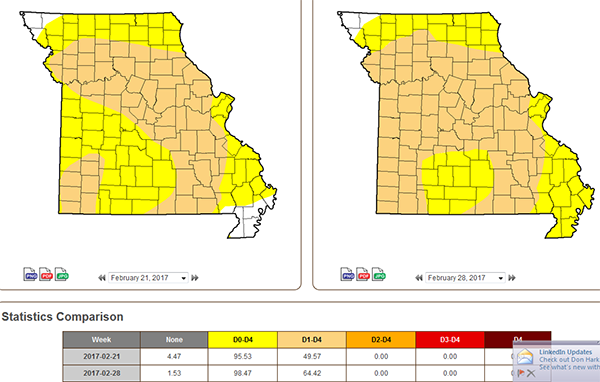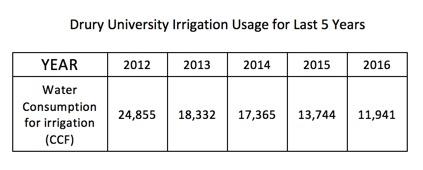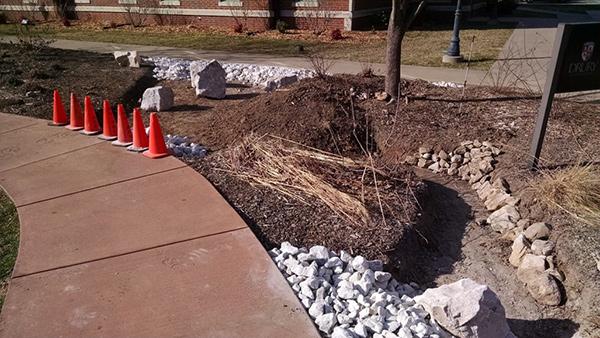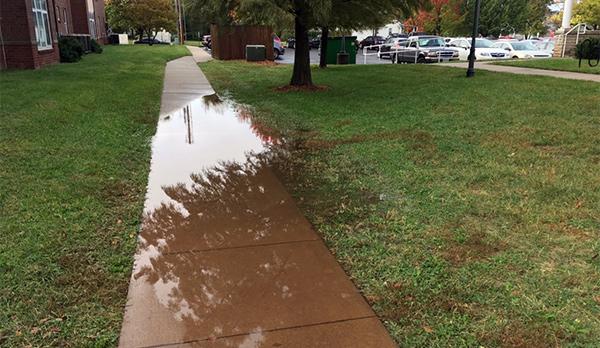Water Conservation on Campus: A Tale of Irrigation and Slow, Spread, Soak
As of February 28, 64% of the State of Missouri is in the moderate drought category according to the U.S. Drought Monitor. This is up from 50% the week before, and as of this writing the remainder of the state was in the abnormally dry category.
By contrast, California, which had been in a several years-long drought, is now declining in all drought categories. 75% of the state is not rated at all and even the stubborn droughty areas of Southern California are getting moisture. In fact, many areas are now concerned they will not be able to manage any more rain heading into the rainy season. This unpredictable variability regarding water, in an industry heavily reliant on water, demonstrates the need to wisely manage and conserve water at all times.

Irrigation Challenges
When I arrived at Drury University the Grounds Department was faced with the following obstacles in our campus irrigation:
- Poorly designed, installed, maintained systems
- Poor communication of water needs for landscape health
- Lack of monitoring of natural rainfall timing and amounts
- Poor cycle planning and regular adjustments
- No desire for water conservation
The main cause for this situation was a lack of adequate irrigation knowledge and responsibility by the in-house staff, and the contractors that installed systems. If either of these parties had fulfilled their professional duties, these challenges could have been avoided.
For most of the readers of TurfNet, the high level of understanding regarding irrigation theory and application decreases these difficulties, but they still do occur. Over the last five years Drury Grounds has taken many steps to increase the effectiveness and efficiency of our irrigation systems. Our approach has been:
- Appropriate cultural practices (mowing height/frequency, soil health, IPM)
- Understanding of appropriate irrigation to promote plant health (E/T)
- Retrofitting of systems to deliver adequate water (coverage, pressure, volume)
- Retrofitting of systems to maximize system efficiency (smart controllers, sensors, efficient heads & nozzles)
- Culture of conservation
- Willingness to eliminate irrigation if appropriate with organizational strategy
We aren't doing anything amazing. But what we are doing is working. Our usage has continued to decline while our overall satisfaction with the landscape continues to increase. My point is that irrigation effectiveness is vital and will promote peripheral landscape benefits as a result. But the pursuit of landscape benefits does not necessarily lead to irrigation conservation.

Stormwater on Campus
Rainfall and stormwater on our campus (courses) is another issue we all face. While we don't have to push up sand in bunkers after a heavy rain, we are still faced with many challenges due to stormwater. These are:
- City of Springfield MS4 permit (EPA term for stormwater runoff)
- Speed with which water moves off campus
- Erosion and damage
- Increase infiltration on campus
- Treatment of water on site (pollution prevention)
- Budget allotments, competing financial pressures
- Slow, Spread, Soak

Existing water issues need functional correction that meshes with the landscape.
Managing stormwater in (on) the landscape is rarely a priority to an organization if consequences are contained in the landscape. But when the water damages infrastructure, there is increased organizational demand to correct it. But dealing with water before it causes damage is the best, and most cost effective, method of management. To do just this Drury Grounds has endeavored to use the following efforts:
- Go to where the problem is
- Take advantage of what water wants to do
- Keep water on campus
- Slow, Spread Soak
- Resource allocation Big Project/Small Project
- Permission?
- $$$$$$$$$

Water problems should be viewed as opportunities for increasing Slow, Spread, Soak. The answer here is a rain garden... not a drain.
Managing stormwater on campus is a win/win effort for our grounds operation. First, it demonstrates our commitment, in a very proactive way, to our University's infrastructure. Dealing with stormwater BEFORE it can create damage is financial stewardship at its best. Next, it is great public relations. Water conservation is always good press. Our efforts in this area show we are concerned with our organization and our community. For an industry that can sometimes be under environmental scrutiny, this goodwill pays dividends.
In conclusion
Water is a valuable resource to both the Grounds manager and the community at large. If we compete for this commodity, then no one wins. Good water management creates allies. When Drury University keeps rainfall on campus it benefits our landscape, but also decreases the amount of water that goes into the sanitary sewers or stormwater system. Nothing written here should be new to grounds Managers. What this blog should do is support water conservation by our industry. When, not if, we face water shortages, it is in our best interest to be seen as a conservation partner, not simply consumers. The best time for water conservation is always.
(This is a strategic blog in support of water conservation. My next blog will be tactical, discussing how Drury University manages stormwater on campus)



0 Comments
Recommended Comments
There are no comments to display.